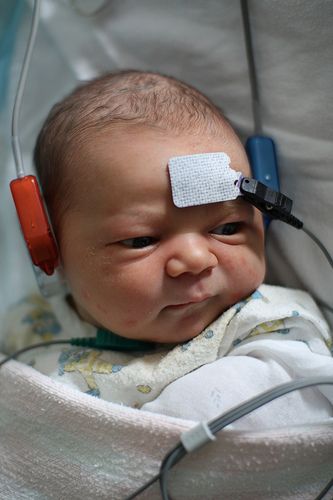Dr. Charles Fernyhough Experiment About Baby With the Brain Hat
Inside baby's brain: How newborns perceive the world

As regular readers of this blog know, I'm a huge fan of the NPR science program
.
One of the show'south hosts, Jad Abumrad, recently had a baby and began to wonder what was going on in his two-calendar month-old son's encephalon — what is sight similar for him, or hearing?
The result of Abumrad's curiousity is Afterward Nascence, a 10-minute brusque podcast. Abumrad interviewed Charles Fernyhough, a British psychologist whose volume, A M Days of Wonder, looked at the scientific discipline of infant encephalon development.
The podcast is fascinating, explaining how babies probably meet the world much brighter than we practice (because, unlike u.s.a., their optics oasis't still developed a film on them) and that they likely hear echos to everything they hear (because their brain hasn't figured out how to process sound properly).
Perhaps the near interesting part of the podcast, though, is when Fernyhough talks near the results of EEG brain scans on infants.
They suggest that babies' brains are so new that sometimes they misfire — lighting upward in the optical area when they hear something or in the auditory area when they see something. In other words — though this is purely speculative — babies may sometimes see colours when they hear something or hear sounds when they see something.
The podcast also contains an interesting — though somewhat depressing — explanation for why newborns sometimes expect at their parents with such an intent, fixed stare.
I'm hoping Abumrad'due south contempo parenthood means we might see more segments on Radiolab that bargain with the science of parenting (ane of my favourite subjects).
On a related topic, Alison Gopnik'southward new book, The Philosophical Infant, has gotten a lot of printing recently (including on CBC's morning show The Current).
Gopnik's volume looks, in office, nearly how babies perceive the globe differently than adults practise. For example, while babies lack the power to focus besides as adults, that means they may actually experience their environment more securely and richly than we do.
I haven't read Gopnik's book yet, but she wrote an interesting slice for The New York Times that summarized some of the research that she covers in her book.
I thought i of the virtually interesting things in Gopnik's slice was actually a written report done here at the University of B.C. that shows babies tin understand probability more than we may realize:
Last year, Fei Xu and Vashti Garcia at the University of British Columbia proved that babies could understand probabilities. Eight-month-old babies were shown a box full of mixed-up Ping-Pong balls: mostly white but with some reddish ones mixed in. The babies were more surprised, and looked longer and more intently at the experimenter when four red balls and 1 white ball were taken out of the box — a possible, yet improbable consequence — than when iv white balls and a red 1 were produced.
Interestingly, Gopnik stresses in her NY Times piece that the enquiry on how babies brains work suggests that — rather than loading our kids up with Babe Einstein and "smart toys" — we should just allow them to play in their own fashion:
Babies' intelligence, the research shows, is very different from that of adults and from the kind of intelligence we normally cultivate in school. Schoolwork revolves around focus and planning. …
This approach may work for children over the age of 5 or so. Only babies and very young children are terrible at planning and aiming for precise goals. …
The learning that babies and young children do on their own, when they carefully watch an unexpected outcome and draw new conclusions from information technology, ceaselessly manipulate a new toy or imagine different ways that the globe might be, is very different from schoolwork.
Babies and young children can acquire about the world around them through all sorts of real-world objects and condom replicas, from dolls to paper-thin boxes to mixing bowls, and even toy cellphones and computers.
So only let your child play and have fun. It's skillful for their brain!
[ Photo past kandinski ]
Source: https://vancouversun.com/news/staff-blogs/inside-babys-brain-how-newborns-perceive-the-world

0 Response to "Dr. Charles Fernyhough Experiment About Baby With the Brain Hat"
Postar um comentário